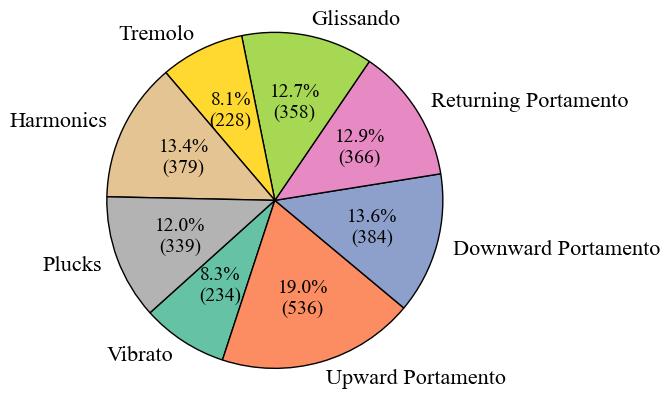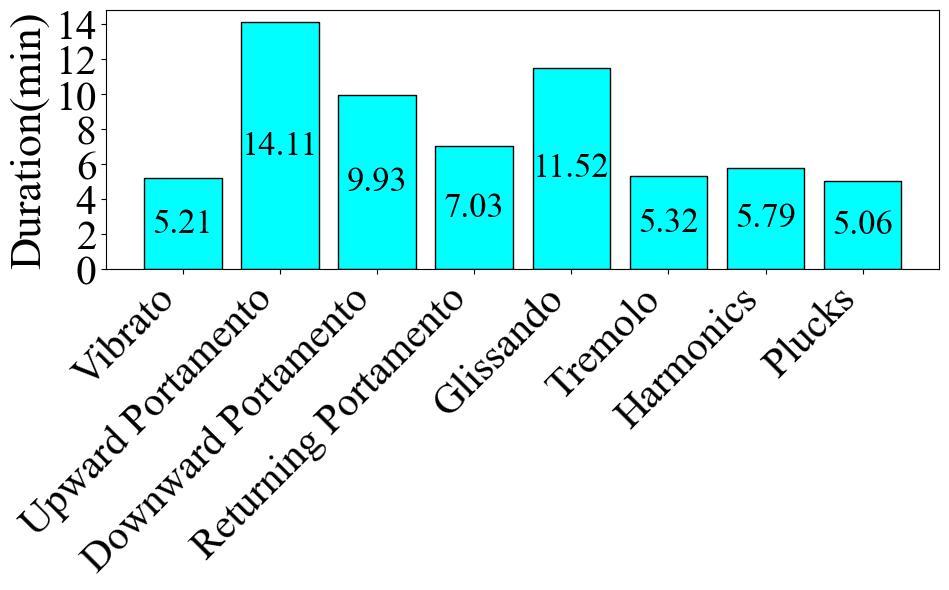Datasets:
audio
audioduration (s) 0.62
11.5
| mel
imagewidth (px) 54
991
| label
class label 8
classes | name
stringclasses 8
values | cname
stringclasses 8
values | pinyin
stringclasses 8
values |
|---|---|---|---|---|---|
3returning_portamento
| returning_portamento | 回滑音 | hui2_hua2_yin1 |
||
3returning_portamento
| returning_portamento | 回滑音 | hui2_hua2_yin1 |
||
4glissando
| glissando | 刮奏, 花指 | gua1_zou4/hua1_zhi3 |
||
2downward_portamento
| downward_portamento | 下滑音 | xia4_hua2_yin1 |
||
1upward_portamento
| upward_portamento | 上滑音 | shang4_hua2_yin1 |
||
0vibrato
| vibrato | 颤音 | chan4_yin1 |
||
4glissando
| glissando | 刮奏, 花指 | gua1_zou4/hua1_zhi3 |
||
7plucks
| plucks | 勾, 打, 抹, 托, ... | gou1/da3/mo3/tuo1/etc |
||
5tremolo
| tremolo | 摇指 | yao2_zhi3 |
||
5tremolo
| tremolo | 摇指 | yao2_zhi3 |
||
3returning_portamento
| returning_portamento | 回滑音 | hui2_hua2_yin1 |
||
3returning_portamento
| returning_portamento | 回滑音 | hui2_hua2_yin1 |
||
1upward_portamento
| upward_portamento | 上滑音 | shang4_hua2_yin1 |
||
1upward_portamento
| upward_portamento | 上滑音 | shang4_hua2_yin1 |
||
1upward_portamento
| upward_portamento | 上滑音 | shang4_hua2_yin1 |
||
3returning_portamento
| returning_portamento | 回滑音 | hui2_hua2_yin1 |
||
2downward_portamento
| downward_portamento | 下滑音 | xia4_hua2_yin1 |
||
5tremolo
| tremolo | 摇指 | yao2_zhi3 |
||
3returning_portamento
| returning_portamento | 回滑音 | hui2_hua2_yin1 |
||
6harmonics
| harmonics | 泛音 | fan4_yin1 |
||
1upward_portamento
| upward_portamento | 上滑音 | shang4_hua2_yin1 |
||
2downward_portamento
| downward_portamento | 下滑音 | xia4_hua2_yin1 |
||
3returning_portamento
| returning_portamento | 回滑音 | hui2_hua2_yin1 |
||
4glissando
| glissando | 刮奏, 花指 | gua1_zou4/hua1_zhi3 |
||
1upward_portamento
| upward_portamento | 上滑音 | shang4_hua2_yin1 |
||
1upward_portamento
| upward_portamento | 上滑音 | shang4_hua2_yin1 |
||
4glissando
| glissando | 刮奏, 花指 | gua1_zou4/hua1_zhi3 |
||
7plucks
| plucks | 勾, 打, 抹, 托, ... | gou1/da3/mo3/tuo1/etc |
||
1upward_portamento
| upward_portamento | 上滑音 | shang4_hua2_yin1 |
||
4glissando
| glissando | 刮奏, 花指 | gua1_zou4/hua1_zhi3 |
||
5tremolo
| tremolo | 摇指 | yao2_zhi3 |
||
1upward_portamento
| upward_portamento | 上滑音 | shang4_hua2_yin1 |
||
5tremolo
| tremolo | 摇指 | yao2_zhi3 |
||
3returning_portamento
| returning_portamento | 回滑音 | hui2_hua2_yin1 |
||
2downward_portamento
| downward_portamento | 下滑音 | xia4_hua2_yin1 |
||
5tremolo
| tremolo | 摇指 | yao2_zhi3 |
||
4glissando
| glissando | 刮奏, 花指 | gua1_zou4/hua1_zhi3 |
||
1upward_portamento
| upward_portamento | 上滑音 | shang4_hua2_yin1 |
||
5tremolo
| tremolo | 摇指 | yao2_zhi3 |
||
3returning_portamento
| returning_portamento | 回滑音 | hui2_hua2_yin1 |
||
3returning_portamento
| returning_portamento | 回滑音 | hui2_hua2_yin1 |
||
4glissando
| glissando | 刮奏, 花指 | gua1_zou4/hua1_zhi3 |
||
2downward_portamento
| downward_portamento | 下滑音 | xia4_hua2_yin1 |
||
1upward_portamento
| upward_portamento | 上滑音 | shang4_hua2_yin1 |
||
6harmonics
| harmonics | 泛音 | fan4_yin1 |
||
1upward_portamento
| upward_portamento | 上滑音 | shang4_hua2_yin1 |
||
2downward_portamento
| downward_portamento | 下滑音 | xia4_hua2_yin1 |
||
0vibrato
| vibrato | 颤音 | chan4_yin1 |
||
1upward_portamento
| upward_portamento | 上滑音 | shang4_hua2_yin1 |
||
6harmonics
| harmonics | 泛音 | fan4_yin1 |
||
1upward_portamento
| upward_portamento | 上滑音 | shang4_hua2_yin1 |
||
1upward_portamento
| upward_portamento | 上滑音 | shang4_hua2_yin1 |
||
0vibrato
| vibrato | 颤音 | chan4_yin1 |
||
1upward_portamento
| upward_portamento | 上滑音 | shang4_hua2_yin1 |
||
7plucks
| plucks | 勾, 打, 抹, 托, ... | gou1/da3/mo3/tuo1/etc |
||
0vibrato
| vibrato | 颤音 | chan4_yin1 |
||
4glissando
| glissando | 刮奏, 花指 | gua1_zou4/hua1_zhi3 |
||
1upward_portamento
| upward_portamento | 上滑音 | shang4_hua2_yin1 |
||
2downward_portamento
| downward_portamento | 下滑音 | xia4_hua2_yin1 |
||
0vibrato
| vibrato | 颤音 | chan4_yin1 |
||
1upward_portamento
| upward_portamento | 上滑音 | shang4_hua2_yin1 |
||
5tremolo
| tremolo | 摇指 | yao2_zhi3 |
||
3returning_portamento
| returning_portamento | 回滑音 | hui2_hua2_yin1 |
||
4glissando
| glissando | 刮奏, 花指 | gua1_zou4/hua1_zhi3 |
||
3returning_portamento
| returning_portamento | 回滑音 | hui2_hua2_yin1 |
||
5tremolo
| tremolo | 摇指 | yao2_zhi3 |
||
2downward_portamento
| downward_portamento | 下滑音 | xia4_hua2_yin1 |
||
4glissando
| glissando | 刮奏, 花指 | gua1_zou4/hua1_zhi3 |
||
7plucks
| plucks | 勾, 打, 抹, 托, ... | gou1/da3/mo3/tuo1/etc |
||
0vibrato
| vibrato | 颤音 | chan4_yin1 |
||
6harmonics
| harmonics | 泛音 | fan4_yin1 |
||
1upward_portamento
| upward_portamento | 上滑音 | shang4_hua2_yin1 |
||
3returning_portamento
| returning_portamento | 回滑音 | hui2_hua2_yin1 |
||
7plucks
| plucks | 勾, 打, 抹, 托, ... | gou1/da3/mo3/tuo1/etc |
||
2downward_portamento
| downward_portamento | 下滑音 | xia4_hua2_yin1 |
||
1upward_portamento
| upward_portamento | 上滑音 | shang4_hua2_yin1 |
||
5tremolo
| tremolo | 摇指 | yao2_zhi3 |
||
2downward_portamento
| downward_portamento | 下滑音 | xia4_hua2_yin1 |
||
0vibrato
| vibrato | 颤音 | chan4_yin1 |
||
1upward_portamento
| upward_portamento | 上滑音 | shang4_hua2_yin1 |
||
2downward_portamento
| downward_portamento | 下滑音 | xia4_hua2_yin1 |
||
4glissando
| glissando | 刮奏, 花指 | gua1_zou4/hua1_zhi3 |
||
7plucks
| plucks | 勾, 打, 抹, 托, ... | gou1/da3/mo3/tuo1/etc |
||
4glissando
| glissando | 刮奏, 花指 | gua1_zou4/hua1_zhi3 |
||
4glissando
| glissando | 刮奏, 花指 | gua1_zou4/hua1_zhi3 |
||
5tremolo
| tremolo | 摇指 | yao2_zhi3 |
||
7plucks
| plucks | 勾, 打, 抹, 托, ... | gou1/da3/mo3/tuo1/etc |
||
4glissando
| glissando | 刮奏, 花指 | gua1_zou4/hua1_zhi3 |
||
7plucks
| plucks | 勾, 打, 抹, 托, ... | gou1/da3/mo3/tuo1/etc |
||
5tremolo
| tremolo | 摇指 | yao2_zhi3 |
||
5tremolo
| tremolo | 摇指 | yao2_zhi3 |
||
1upward_portamento
| upward_portamento | 上滑音 | shang4_hua2_yin1 |
||
4glissando
| glissando | 刮奏, 花指 | gua1_zou4/hua1_zhi3 |
||
6harmonics
| harmonics | 泛音 | fan4_yin1 |
||
7plucks
| plucks | 勾, 打, 抹, 托, ... | gou1/da3/mo3/tuo1/etc |
||
2downward_portamento
| downward_portamento | 下滑音 | xia4_hua2_yin1 |
||
2downward_portamento
| downward_portamento | 下滑音 | xia4_hua2_yin1 |
||
3returning_portamento
| returning_portamento | 回滑音 | hui2_hua2_yin1 |
||
3returning_portamento
| returning_portamento | 回滑音 | hui2_hua2_yin1 |
||
1upward_portamento
| upward_portamento | 上滑音 | shang4_hua2_yin1 |
Dataset Card for GZ_IsoTech Dataset
Original Content
The dataset is created and used for Guzheng playing technique detection by [1]. The original dataset comprises 2,824 variable-length audio clips showcasing various Guzheng playing techniques. Specifically, 2,328 clips were sourced from virtual sound banks, while 496 clips were performed by a professional Guzheng artist.
The clips are annotated in eight categories, with a Chinese pinyin and Chinese characters written in parentheses: Vibrato (chanyin 颤音), Upward Portamento (shanghuayin 上滑音), Downward Portamento (xiahuayin 下滑音), Returning Portamento (huihuayin 回滑音), Glissando (guazou 刮奏, huazhi 花指...), Tremolo (yaozhi 摇指), Harmonic (fanyin 泛音), Plucks (gou 勾, da 打, mo 抹, tuo 托...).
Integration
In the original dataset, the labels were represented by folder names, which provided Italian and Chinese pinyin labels. During the integration process, we added the corresponding Chinese character labels to ensure comprehensiveness. Lastly, after integration, the data structure has six columns: audio clip sampled at a rate of 44,100 Hz, mel spectrogram, numerical label, Italian label, Chinese character label, and Chinese pinyin label. The data number after integration remains at 2,824 with a total duration of 63.98 minutes. The average duration is 1.36 seconds.
Based on the aforementioned original dataset, we conducted data processing to construct the default subset of the current integrated version of the dataset. Due to the pre-existing split in the original dataset, wherein the data has been partitioned approximately in a 4:1 ratio for training and testing sets, we uphold the original data division approach for the default subset. The data structure of the default subset can be viewed in the viewer. In addition, we have retained the eval subset used in the experiment for easy replication.
Data Structure
https://huggingface.co/datasets/ccmusic-database/GZ_IsoTech/viewer
Data Instances
.zip(.flac, .csv)
Data Fields
Categorization of the clips is based on the diverse playing techniques characteristic of the guzheng, the clips are divided into eight categories: Vibrato (chanyin), Upward Portamento (shanghuayin), Downward Portamento (xiahuayin), Returning Portamento (huihuayin), Glissando (guazou, huazhi), Tremolo (yaozhi), Harmonic (fanyin), Plucks (gou, da, mo, tuo…).
Dataset Description
Dataset Summary
A dataset for Guzheng playing technique classification
Statistics
Firstly, Fig. 1 illustrates the number and proportion of audio clips in each category. The category with the largest proportion is Upward Portamento, accounting for 19.0% with 536 clips. The smallest category is Tremolo, accounting for 8.1% with 228 clips. The difference in proportion between the largest and smallest categories is 10.9%. Next, Fig. 2 displays the total audio duration for each category. The category with the longest total duration is Upward Portamento, with 14.11 minutes, consistent with the results shown in the pie chart. However, the category with the shortest total duration is Plucks, with a total of 5.06 minutes, which differs from the ranking in the pie chart. Overall, this dataset is comparatively balanced within the database. Finally, Fig. 3 presents the number of audio clips distributed across different duration intervals. Most of the audio clips are concentrated in the 0-3 second range. Among them, 1,742 audio clips are concentrated in the 0-1.5 second range, while 1,033 clips are concentrated in the 1.5-3 second range. Only 49 clips exceed 3 seconds in length.
| Statistical items | Values |
|---|---|
| Total count | 2824 |
| Total duration(s) | 3838.6787528344717 |
| Mean duration(s) | 1.359305507377644 |
| Min duration(s) | 0.3935827664399093 |
| Max duration(s) | 11.5 |
| Eval subset total | 2899 |
| Class with max durs | Glissando |
Supported Tasks and Leaderboards
MIR, audio classification, Guzheng playing technique classification
Languages
Chinese, English
Usage
Default subset
from datasets import load_dataset
ds = load_dataset("ccmusic-database/GZ_IsoTech", name="default")
for item in ds["train"]:
print(item)
for item in ds["test"]:
print(item)
Eval subset
from datasets import load_dataset
ds = load_dataset("ccmusic-database/GZ_IsoTech", name="eval")
for item in ds["train"]:
print(item)
for item in ds["validation"]:
print(item)
for item in ds["test"]:
print(item)
Maintenance
GIT_LFS_SKIP_SMUDGE=1 git clone git@hf.co:datasets/ccmusic-database/GZ_IsoTech
cd GZ_IsoTech
Mirror
https://www.modelscope.cn/datasets/ccmusic-database/GZ_IsoTech
Additional Information
Dataset Curators
Dichucheng Li
Evaluation
[1] Li, Dichucheng, Yulun Wu, Qinyu Li, Jiahao Zhao, Yi Yu, Fan Xia and Wei Li. “Playing Technique Detection by Fusing Note Onset Information in Guzheng Performance.” International Society for Music Information Retrieval Conference (2022).
[2] https://huggingface.co/ccmusic-database/GZ_IsoTech
Citation Information
@inproceedings{LiWLZ0X022,
author = {Dichucheng Li and Yulun Wu and Qinyu Li and Jiahao Zhao and Yi Yu and Fan Xia and Wei Li},
title = {Playing Technique Detection by Fusing Note Onset Information in Guzheng Performance},
booktitle = {Proceedings of the 23rd International Society for Music Information Retrieval Conference, {ISMIR} 2022, Bengaluru, India, December 4-8, 2022},
pages = {314-320},
year = {2022}
}
Contributions
A dataset for Guzheng playing technique
- Downloads last month
- 88


